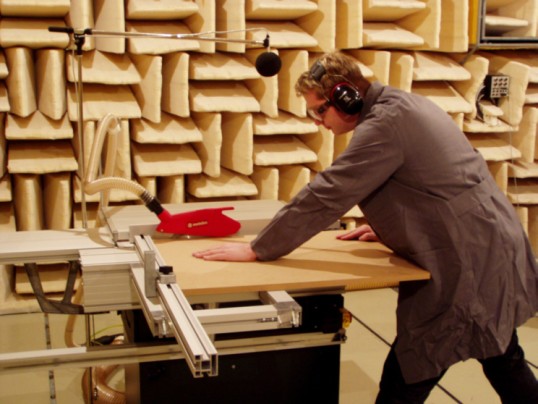- Artificial Intelligence (AI)
- Occupational exposure limit values
- Climate Change and Occupational Safety
- List of CMR substances
- Electromagnetic fields
- Ergonomics
- Industrial Security
- Collaborative robots
- Noise
- Nanoparticles at the workplace
- Optical Radiation
- REACH
- Reference materials
- Proficiency testing
- Vibration
- Virtual reality
- Work 4.0
The circular saw as a noise source: Simple solutions for noise reduction at the workplace
Risks of hearing damage presented by circular saws
The high noise emissions are a major source of noise exposure for workers working on circular saws and at neighbouring workplaces. Circular saws are used at many workplaces in wood processing companies, and also in companies in the metal and plastics processing industries.
On circular saws, the high sound pressure level is usually caused by the saw blades. Where conventional saw blades are used, these levels always reach or exceed 85 dB(A) at which they present a risk to hearing. The highest levels, i.e. exceeding 95 dB(A), are attained during sawing of plastic and metal; even for wood, the noise exposure is still 85 to 90 dB(A). At sound pressure levels of 85 dB(A) or higher, experts assume that a risk exists of the hearing being harmed. For this reason, the German Noise and Vibrations Occupational Safety and Health Ordinance (LärmVibrationsArbSchV) stipulates that at or above this value, measures must be taken for protection against noise, and hearing protectors have to be used. In most scenarios, the use of low-noise circular saw blades substantially reduces the sound pressure level.
Efficacy of low-noise saw blades
Considerable reductions in the sound level can be achieved by means of low-noise saw blades:
- Up to approx. 13 dB(A) with the saw idling
- Up to approx. 6 dB(A) during sawing aluminium
- Up to approx. 11 dB(A) during sawing wood panels
- Up to approx. 11 dB(A) during sawing plastic profiles
- Up to approx. 13 dB(A) during sawing squared hardwood timber
The efficacy of low-noise saw blades can be seen from the fact that a reduction of 3 dB equates to halving of the sound energy, and thus significantly reduces the risk of harm to the hearing. A noise level reduced by 10 dB is perceived by humans as being only half as loud.
The noise protection worksheet IFA-LSA 02-375 for low-noise diamond stone-cutting saw blades has been published in 2015 (in German).
Bibliography

Schelle, F.; Janssen, M.; Maue, J.H.: Neuartige lärmgeminderte Sägeblätter für die Holzbearbeitung. DAGA 2016. 42. Deutsche Jahrestagung für Akustik, 14-17 March 2016 in Aachen (conference paper) CD-ROM, pp. 1226-1228, published by: Becker, S. Gesellschaft für Akustik, Berlin 2016. ISBN: 978-3-939296-10-2
Low-noise tools

- Noise protection worksheet IFA-LSA 02-375: low-noise diamond cutting discs for stone processing
- Noise protection information IFA-LSI 01-200 (web application): Noise reduction at workplaces – Sources of supply for noise control materials, assembly parts and tools.
Contact
Ergonomics, Physical environmental factors
Tel: +49 30 13001-3410Fax: +49 30 13001-38001
